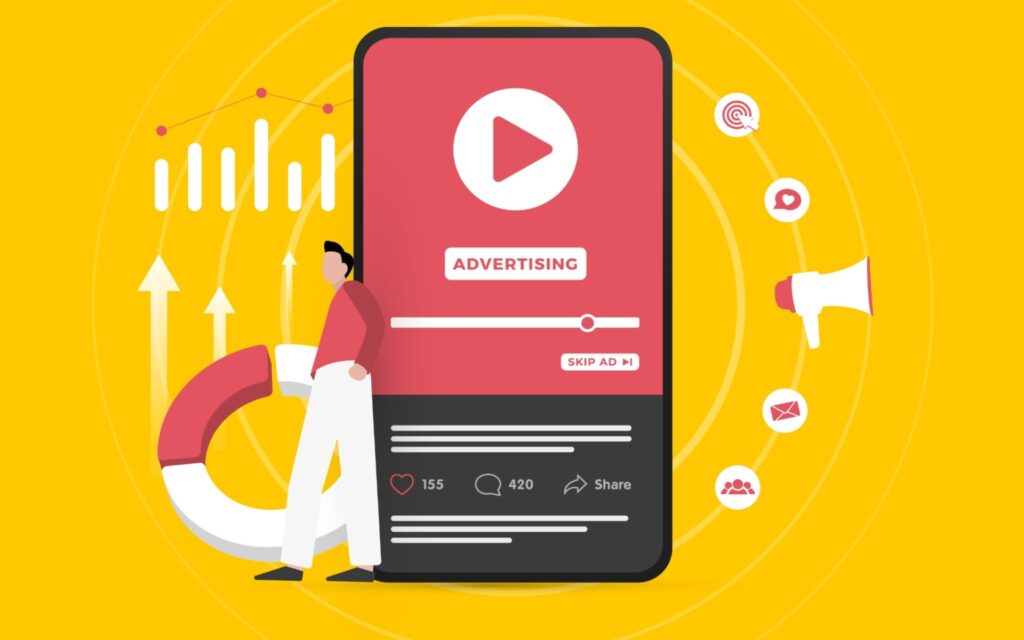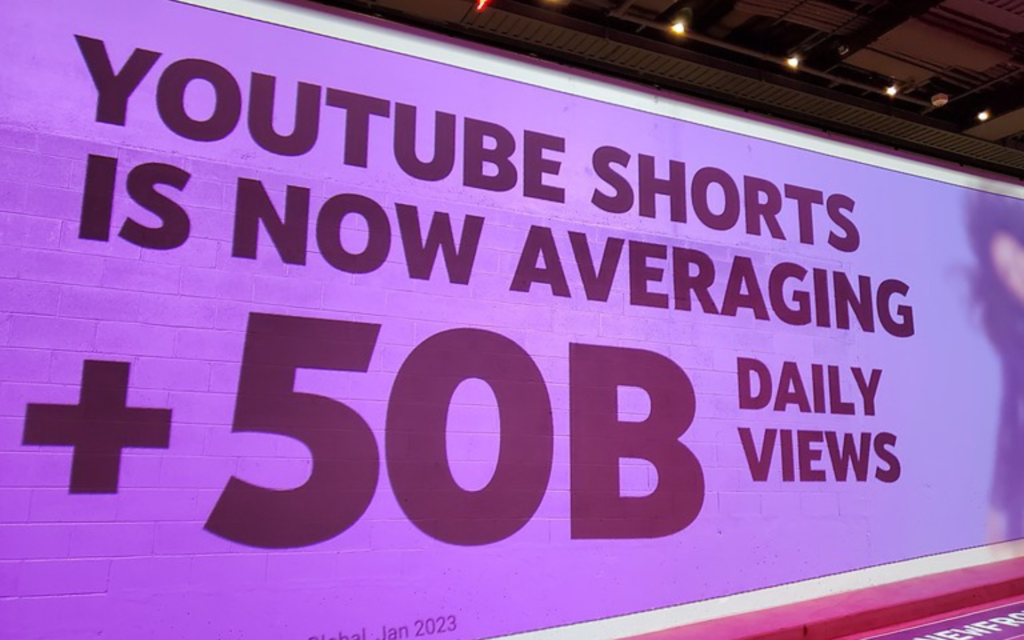YouTube NewFront 2023 Showcased Shorts To Reach Gen Z

Learn about YouTube’s NewFront 2023, including best practises and how YouTube is showcasing shorts to reach Generation Z.
On Monday, May 1st, the annual YouTube NewFront showcased innovative methods to reach Generation Z through YouTube Shorts.
Four days of presentations had just begun at Google’s Pier 57 in New York City for the brands, agencies, and media purchasers in attendance.
Therefore, YouTube attempted to impart three memorable messages to the audience before TikTok’s presentation on Thursday, May 4th.
As I entered Pier 57, it was not difficult to discern Big Red’s first message: “YouTube Shorts is now averaging more than 50 billion daily views.”
I later learned that 1.5 billion of YouTube’s billions of monthly logged-in users watch shorts.
When I opened the YouTube NewFront programme, the company’s second essential message was immediately apparent: “Gen Z and YouTube go way back.”
Now, Generation Z has never known a world without 24-hour access to YouTube creators’ content.
And “74% of Generation Z YouTube viewers agree that the platform offers exclusive content.”
To emphasise this point, the YouTube NewFront event featured Jon Youshaei, who spoke in depth about “what matters to Generation Z viewers.”
And we discovered:
• Seventy-seven percent of this target audience believe the platform allows them to curate their own entertainment.
• Seventy-three percent of YouTube’s Gen Z viewers concur that the platform is the best location to find diverse viewpoints on a topic.
• More than half of Gen Z YouTube viewers find the platform’s creators appealing because they are “real and authentic.”
Then, Youshaei and Asia Jackson, Larray, and Darcei Giles entertained the audience with “Creator Games: Generation Z Edition.”
Kristen O’Hara, Vice President of Agency and Brand Solutions at Google, announced two “new ways to build awareness with YouTube shorts.” I didn’t need a secret decoder ring to figure out the third key message.
The two announcements of news were:
• Increasing the use of video shorts in marketing campaigns
• The YouTube Select Run of Shorts lineup is introduced.
For additional information, please see “Google Strengthens Advertising on YouTube Shorts.”
So, what beyond-the-obvious insightful analysis or intriguing information can I add?
After attending this year’s YouTube NewFront, I could not stop ruminating about what Jim Barksdale, president and CEO of Netscape from 1995 to 1999, said during the first browser conflict with Microsoft.
In a battle between a bear and an alligator, the terrain determines the victor.
It is pertinent to inquire, “Why did YouTube choose to combat on TikTok’s turf? Was it a strategic error to highlight new approaches to raising awareness with shorts to reach Generation Z? What alternatives were there?”
To be fair, nobody at YouTube’s NewFront event mentioned “TikTok.”
The emphasis on short-form video, Generation Z, and brand awareness and reach, however, passed the duck test: “If it looks like a duck, swims like a duck, and quacks like a duck, then it is probably a duck.”
Hey, maybe these are the three most important topics that traditional advertising agencies and media purchasers want to hear about, given that these are the goals that the vast majority of their clients have for video campaigns.

However, according to research that the CMO Council released last month,
“More than 70 percent of marketers lack confidence in their current sales and marketing models to effectively sell in the digitalized customer journey.”
Therefore, informing your audience what they want to hear may be a strategic error. What is the substitute?
YouTube could have offered a more comprehensive overview of YouTube and video marketing for brands and their digital marketing agencies.
First, shorts are merely one of the options available to content creators who wish to make videos for YouTube’s billions of users.
Brands may also utilise long-form content, such as “Fursat: A Vishal Bhardwaj Film.”
“Fursat” is a fantastical tale about a man so preoccupied with controlling the future that he risks losing what he values most in the present. Vishal Bhardwaj, the director, captured it on an iPhone 14 Pro. It has received 144 million views and 339,000 engagements despite being over 30 minutes long.
Additionally, brands can use YouTube Live to broadcast events, teach seminars, or give viewers a real-time look at their business.
For instance, Sticky, a manufacturer of candies, allows viewers to observe its skilled confectionery artisans and sculptors create the most fantastic and delectable works of art in both short-form and live formats. The Australian brand broadcasts live on Saturday at 2:00 p.m. in Sydney’s time zone. The title of its most recent webcast is “Dinosaurs in Candy.”
Sticky has uploaded 356 videos over the past year, which have received 1,100,000,000 views and 60,400,000 engagements. This indicates that the average video received 3,1,000,000 views and 170,000 engagements, for a 5.4% engagement rate.
Traditional advertising agencies and media purchasers may not be interested in hearing about these creative options, but brands and digital marketing agencies must be aware of them.
Second, you can reach YouTube’s billions of users through a variety of targeting options, including Gen Z. However, you shouldn’t send Millennials, Gen X, and Baby Boomers out to pasture, particularly if your company or client operates in the automotive, business-to-business, consumer packaged goods, finance and banking, retail, or travel industries.
Check out, for instance, “A Place for Together—Only Your People.”
This advertisement received 319 million views on YouTube. However, only 15.2% of the audience is 18–24. Comparatively, 34.9% are between the ages of 25 and 34, 24.0% are between the ages of 35 and 44, 11.1% are between the ages of 45 and 54, and 13.5% are 55 and older.
And YouTube’s targeting options are not limited to demographic categories (such as age, gender, familial status, and household income).
There are numerous additional methods to segment your target audience, including:
• affinity segments, which are based on individuals’ preferences and interests.
• In-market segments, which are based on recent intent to purchase
• Segments with comparable interests to those of your website visitors or current customers
• Specific demographic segments, including college students, homeowners, and new parents
• Your data segments, which are derived from your consumer data or individuals who have interacted with your videos, video advertisements, YouTube channel, website, and applications.
• Customised segments based on the keywords the user has recently searched for on Google.com
• Life-event segments, including relocation, college graduation, and marriage
Third, brand awareness and reach are not the only available video campaign objectives. Other examples include:
• Increase brand awareness when prospective customers are conducting product investigations or shopping. Brand lift surveys enable brands to align their video marketing campaigns with their marketing objectives by measuring consideration, ad recall, and brand awareness.
• Use video action campaigns to increase sales, prospects, and website traffic. With the introduction of engaged-view conversions (EVCs) from YouTube in Google Analytics 4 (GA4), brands can now measure when a user observes a YouTube video for at least 10 seconds and converts on their website within 3 days of watching the video.
There are additional video campaign objectives that YouTube can help brands attain.
Anne Marie Nelson-Bogle, the VP of YouTube Ads Marketing, interviewed Esi Eggleston Bracey, the president of Unilever USA, at the conclusion of the YouTube NewFront event about Dove’s campaign to pass the CROWN Act, the first law to prohibit race-based hair discrimination in the workplace and in schools.
Dove produced a series of videos addressing the issue, including “As Early as Age Five: End Race-Based Hair Discrimination.”
The campaign informed viewers of the following:
• A black woman is 80% more likely to alter her natural hairstyle to conform to social norms or workplace expectations.
• Black women are 1.5 times more likely to be sent home from the workplace or to know a black woman who was sent home because of her tresses.
• One in two black children has experienced hair discrimination as early as age five, with lifelong consequences.
In addition, Dove co-founded the CROWN Coalition with the National Urban League, Colour of Change, and the Western Centre for Law & Poverty in order to promote anti-hair discrimination legislation. Twenty states have already signed the CROWN Act into law, as witnessed by the coalition.
Now, establishing awareness with Shorts to reach Gen Z may be what traditional advertising agencies and media purchasers want to hear about, as more than 70 percent of marketers who lack confidence in their current sales and marketing model have requested it.
However, brands and digital marketing agencies must be aware that YouTube can be used for even more in order to sell effectively in the digitalized consumer journey.
However, there is more!
At YouTube’s NewFront event, O’Hara stated that YouTube accounted for 52 percent of ad-supported streaming view time on connected TVs among adults aged 18 and older.
I asked a Google spokesperson, “Are there any new developments, case studies, or research for brands and businesses that wish to reach audiences on the largest screen?” “For example, what are the most recent statistics regarding the total audience reached by YouTube CTV, and how will the YouTube NFL Sunday Ticket likely capitalise on this?”
A Google spokesperson said:
• As linear TV viewers migrate to streaming, YouTube’s momentum continues to grow.
• According to Nielsen’s Total TV Report, YouTube has the most viewing time among streaming services.
• According to Nielsen NMI data, other ad-supported streaming services were unable to reach over 30 percent of YouTube viewers aged 18 and older in October 2022.
• Over 65 percent of YouTube CTV view time in the United States is spent on content that is 21 minutes or longer.
It’s also the most popular streaming service among viewers!
• According to a Kantar survey of weekly video viewers, more than half indicate that YouTube is the first app they launch on their CTV. This indicates that more Americans watch YouTube and YouTube TV in their living rooms than any other platform.
• This is because YouTube has an always-on, constantly-updated stream of diverse creator content in addition to a vast selection of traditional and studio-produced content and, later this year, NFL Sunday Ticket on YouTube TV and Primetime Channels!
• YouTube also provides advertisers with a variety of ad solutions to reach viewers accessing YouTube on CTV.
• YouTube Select provides you access to the most popular content that viewers can’t get enough of if you want to be in sync with what’s trending.
• If you want to own the moment, First Position Moments will broadcast your ad first, connecting your message to the content that viewers enjoy at the right time for your brand.
• As announced at NewFronts, these solutions are now available on Shorts!
And IAB’s 2022 Video Ad Spending and 2023 Forecast recently reported:
“CTV continues to distinguish itself within the TV and video landscape by being the go-to channel for audience targeting, measurement, and scale.”
Don’t neglect the family room television when establishing video campaign objectives.
In addition, Youshaei mentioned at this year’s YouTube NewFront that YouTube has paid $50 billion to creators, artists, and media companies over the past three years.
I asked a Google spokesperson, “To what extent does this give YouTube an advantage in attracting and retaining creators and influencers over competitors?”
A Google spokesperson said:
• As previously stated, Americans spend more time in their living rooms streaming YouTube and YouTube TV than any other platform. This has a significant impact on our YouTube creators!
• Creators provide viewers with options and variety unavailable elsewhere.
• Creators are the content studios of this generation, and they submit new successes every day, minute by minute, fueling a constant stream of new content that keeps viewers engaged. YouTube creators are constantly innovating to keep their audiences interested, exercising their creativity across short and long-form, vertical and horizontal, and low-fi and high-production videos.
• In the on-demand world of the present, where viewers, not networks, ultimately determine what is popular, our creators are cultivating passionate fan bases that generate viewership. As long as consumers retain authority, YouTube will be home to the highest-quality content.
Due to these factors, YouTube continues to be a significant advertising platform.
Which business model is therefore more likely to sustain the Creator Economy this year, next year, and the year after?
In the rear of the programme that Big Red distributed at the YouTube NewFront in 2023 was a two-page spread from Google Creative Works, the hub for Google’s most recent research on creative efficacy.
The ad’s headline stated, “Only 30% of YouTube advertisements adhere to creative best practises.”
If this topic merited two of the eight pages in the programme, I would have expected at least a mention of best practises for YouTube video advertisements during the YouTube NewFront event.
Among the ABCDs of effective video advertisements are:
• Pay close attention: captivate the audience immediately with an immersive story.
• Branding: Brand early and frequently with a variety of components.
• Connection: Motivate people to consider or feel profoundly about something.
• Direction: request that individuals take action or do something next.
Conclusion
Let me summarise the opportunity you face using the parable of the blind men and the elephant.
This is a story about a group of visually impaired men in the ancient Indian subcontinent who have never encountered an elephant and who learn and envision what an elephant is like by handling only one part of the elephant, such as the side, tusk, trunk, knee, ear, or tail.
Well, the moral of this fable is as applicable today as it was in ancient India: To be an effective marketer, you must see the elephant in its entirety. If you only contact the trunk, you may incorrectly conclude, “The elephant is very similar to a serpent!”
Last week’s YouTube NewFront event should not have disregarded shorts, Generation Z, or brand awareness and reach. However, these topics could have been emphasised within the context of a much larger narrative.
Neal Mohan, YouTube’s new CEO, published a lengthy letter on YouTube’s 2023 priorities on March 1, 2023. The letter outlined plans to support creators by extending subscription, shopping, and digital product offerings, as well as by investing in new features and artificial intelligence.
For additional information, see “YouTube’s Priorities for 2023: New Ways to Make Money, AI Tools.”
And this gigantic tale may have been the elephant in the room.
I attended the YouTube NewFront event on May 1 with the hope of gaining insight into YouTube’s strategic trajectory.
With notable exceptions, the majority of what I heard was a tactical discussion that left me with the impression that YouTube is very similar to TikTok. Thus, TikTok became the bull in the room.
For this reason, I believe it was a strategic error to showcase new methods to develop brand awareness with Shorts to reach Generation Z.
What were the options?
To return to my earlier zoological analogy, a more comprehensive view of YouTube’s strategic trajectory would have shifted a battle between a bear and an alligator to a winning terrain for YouTube.

